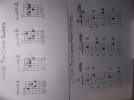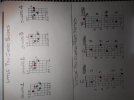Russ
Blues Newbie
(copied from Mental Brick Walls thread)
Quote
I'm working on Lesson 10. Some of the shapes are familiar, but the lesson is proving that just knowing the circle of 5ths doesn't mean you know the fretboard. Embarrassed I'm theorizing that if I try to learn the fretboard in smaller chunks, say 4-5 frets from e-E, maybe that will help me remember the board on sight sooner. I can do the circle and can even do the letters out of order, but if I just pick a fret and ask myself what note it is, I can't just blurt it out. I have to think about it. I'm a perfectionist about things like this and have been learning to be more lenient on myself, but this learning curve is proving wider than my patients is allowing. I mean I'm getting the shapes and fret positions down, but I can't do it in good time or anything. At this point I'm going for placement not remembering at the time why each finger goes to it's position. That's frustrating me. Undecided
Quote
I'm working on Lesson 10. Some of the shapes are familiar, but the lesson is proving that just knowing the circle of 5ths doesn't mean you know the fretboard. Embarrassed I'm theorizing that if I try to learn the fretboard in smaller chunks, say 4-5 frets from e-E, maybe that will help me remember the board on sight sooner. I can do the circle and can even do the letters out of order, but if I just pick a fret and ask myself what note it is, I can't just blurt it out. I have to think about it. I'm a perfectionist about things like this and have been learning to be more lenient on myself, but this learning curve is proving wider than my patients is allowing. I mean I'm getting the shapes and fret positions down, but I can't do it in good time or anything. At this point I'm going for placement not remembering at the time why each finger goes to it's position. That's frustrating me. Undecided


